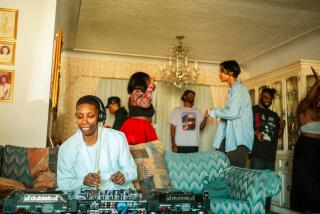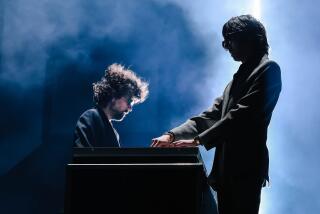Groovin’ to the MP3
- Share via
There’s a video clip making the rounds on YouTube featuring English actor Steve Coogan from the U.K. television show “Saxondale” talking about the state of DJs in the post-vinyl era. “What on God’s green Earth is that?” Coogan asks incredulously of a club track playing on the car stereo. “These days [to be a DJ] you need to know how to operate Windows XP. . . . What do they practice? Moving the mouse around?”
Well, maybe.
Last weekend at the Coachella Valley Music and Arts Festival, there were plenty of cursors moving across screens (though to be fair, few of those computers were running Windows XP; more like a variant of Macintosh’s OS X). But the new school of DJs playing the festival certainly didn’t need practice selecting the right MP3s to play -- DJs have embraced MP3s as the format of choice, heading to websites like beatport.com to download new material and leaving behind bulky albums and CDs in favor of managing their files with software like Serato Scratch Live and Traktor.
“When you are a vinyl DJ, you have to wait to get tracks on vinyl before you can play them out,” offers L.A. fixture Steve Aoki. “Since Serato, you can play anything you produce the second [it’s] ready to go -- and you don’t have to carry crates of records anywhere.”
Of course, relying heavily on technology isn’t without risk. There’s always the possibility of a crash that could bring the party to an abrupt halt.
“I’ve been pretty fortunate in that I’ve never had a crash,” says electronic artist Deadmau5 (whose adopted moniker is pronounced Deadmouse but whose real name is Joel Zimmerman). “I’m using custom-built software, which helps.”
Not every dance music purveyor has been so lucky. British DJ Sasha has been very public about his reluctance to switch over to crash-prone computers when playing live and his subsequent late transition to using a Macintosh G5 instead of vinyl or CDs. So, naturally, he was the one to experience every DJ’s worst nightmare before a high-profile engagement in Miami three months ago during the annual dance music confab known as the Winter Music Conference.
“Ten minutes before I was supposed to play at [South Beach club] Mansion, . . . I was just about to go on and play and my system crashed,” he says. “I made a last-minute call to a friend, and he brought me a spare controller. . . . I went on a half-hour late, and it messed up my entire night, to be honest. If you don’t know what caused the glitch, it stresses you out.”
Now, though, he’s become a convert. Sasha, who played Coachella on April 26, is using Ableton software for his Mac to play live. He says it’s a “rare occurrence” that he has a fatal tech error that stops his set and that the “pluses outweigh the minuses” when it comes to using a computer-based platform.
“For the first six months, I was like a kid with a new toy,” he says of his relatively new set-up. “But it didn’t sound like me . . . it’s almost like I had to train myself to sound like myself again.” He sighs, adding: “I had to remember that it wasn’t necessary to over-layer every track with effects.”
Zimmerman, who programs his own sets instead of traditional “DJ’ing,” likes to experiment with his own material on the fly, an example being his beloved progressive house track “Faxing Berlin,” using code he wrote himself.
“I use different software all the time,” he says. “The methodology of writing [in dance music] involves multiple passes, experimentation . . . stuff that you have to go back and edit. I’d be hard-pressed to be able to do that live on stage. But I always try to insert some elements that are new so that I’m at least performing the track. Audio technology keeps coming out with new stuff. If it’s new, exploit it. That’s the whole idea behind technology.”
--
More to Read
The biggest entertainment stories
Get our big stories about Hollywood, film, television, music, arts, culture and more right in your inbox as soon as they publish.
You may occasionally receive promotional content from the Los Angeles Times.










